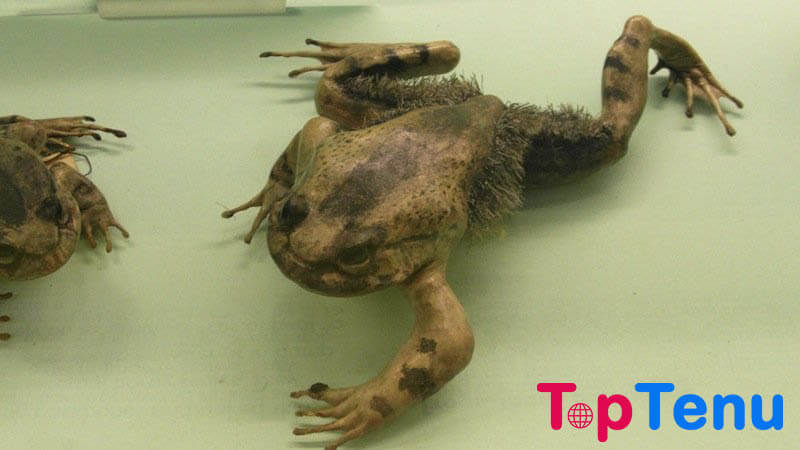Top 10 Weird Animal Defense Mechanisms
1. Opussum

The opossum has a number of tricks up its sleeve. It can foam at the mouth to try to convince predators that it’s toxic, or it can emit a green anal fluid that smells just as bad as a skunk.
The opossum’s main self-defense mechanism is its ability to play dead. Predators generally prefer to kill their own prey and tend to lose interest if the animal is already deceased.
The amazing thing about this defensive method is that playing dead is a physiological response, and the animal falls into a comatose state that can last for hours.
Related: Top 10 Fastest Animals in the World
2. Pebble Toad

This species of toad is specifically found in Venezuela. The Pebble toad has an incredible defensive strategy, when they feel threatened it will fold itself into a ball and roll away.
Now you may think that rolling all the way down a hill or mountain may injure the toad but Since the Toad is light weight, and only about an inch long it doesn’t hurt them all and gives them the ability to quickly escape danger.
3. Hairy Frog

Also known as the wolverine frog this species of frog gets its name from the hair like structures on its body. It also has another notable – and terrifying ability – when the hairy frog feels threatened it intentionally breaks the bones of its toes. The broken bones become an instant weapon, pushing through the skin and being used as extendable claws.
4. Baby Komodo Dragons

These living dragons are the stuff of nightmares. Growing up to ten feet long and weighing as much as 400 pounds Komodo dragons have been known to attack humans. Baby Komodo Dragons have to defend themselves against being eaten by the adults.
How do they do this? Baby Komodo Dragons will cover themselves in feces, knowing the smell will repulse adult dragons.
Related: Top 10 Most Intelligent Animals in the World
5. Hagfish

Hagfish are eel like creatures about a foot long, that have no jaw or teeth. When a hagfish is attacked or feels threatened, it will secrete slime from hundreds of pores.
This slime may be just a minor nuisance to humans, but to other fish it can choke them as the slime can clog their gills.
The amount of slime produced is astounding, just 1 hagfish can produce enough slime to fill a milk jug. As soon as the hagfish feels safe again, it will tie itself in a knot, a process that wipes the slime away from its body.
6. Pygmy Sperm Whale

The Pygmy Sperm whale is rarely seen and only grows to be about 4 feet long. Because of their small size, it makes them vulnerable to predators such as sharks and orcas.
As a result of this, the Pygmy Sperm whale employs a disgusting method of self-defense.
When startled, it releases a cloud of reddish-brown fluid, and then uses its tail to stir it up forming a large dark cloud to conceal itself. This gives the whale the ability to quickly dive and escape to safety.
7. Northern Fulmar

This seabird is primarily found in subarctic regions and looks similar to a standard sea gull. The young chicks, although cute and fluffy, have developed a revolting method of self-defense.
When confronted, the fulmar chick will projectile vomit all over the attacker’s face. The bright orange vomit creates a rotten fish smell, and coats the feathers of the attacking bird, rendering it unable to fly.
8. Bombardier Beetles

These Carnivorous beetles are found on most continents and live typically in grasslands or woodlands. Looking somewhat innocent, it’s famous for being able to spray boiling hot and toxic bodily fluids towards its attacker.
9. Malaysian Exploding Ant

As the name suggests, these black and orange ants have a unique and suicidal self-defense mechanism. The ant colonies consist of a queen, drones, worker ants and soldier ants.
The soldier version comes with glands full of poison. When it feels there is a legitimate threat to the colony, it will contract its abdomen causing the glands to explode and spray poison in all directions.
Although the ant dies in the process, the poison is enough to take down the attacker, and ensure the safety of the colony.
10. Horned Lizard

At the top of our list, we have the horned Lizard. Found in the deserts from North to Central America, you would think these lizards appear to be well protected by all of their spikes.
Unfortunately for the attacker, the horned lizard has another gruesome self-defense ability – shooting blood from its eyes.
When attacked, it pressures its own sinus cavities until blood vessels burst, and the resulting pressure creates a jet stream of blood that shoots up to 4 feet.




